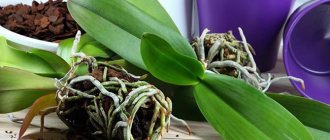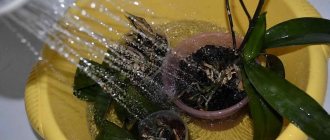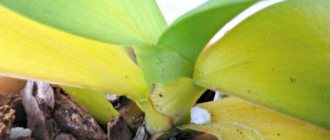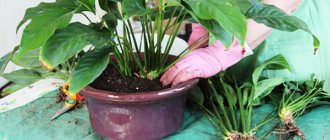Pulling the flower by the stem
The most common mistake when replanting is trying to pull parts of the plant when removing it from a purchased container. You need to carefully pry off the flower using available tools. If necessary, you can tap on the bottom, but it is strictly forbidden to pull on the stem.
After removing the plant, you need to clean the root a little. This will help speed up growth. After this, soil is poured into a new pot, the plant is placed there and soil is added on top. Then water the flower.
What to do to resuscitate a flower?
When the first painful signs appear, the plant needs attention and the elimination of factors that provoke the death of the plant. Each problem has its own causes and requires a specific approach. First of all, it is necessary to determine what provokes this state of plants, and then move on to resuscitation of the flower.
Dropped the leaves
In case of insufficient watering and dry air, the following measures are necessary::
- Place the flower pot in a container of water for 15-20 minutes. During this time, the soil will be saturated with moisture, and the roots will begin to receive the missing substances.
- Spray spathiphyllum 2 times a day with purified, warm water.
- Make sure there is sufficient air humidity - use a household humidifier, you can also place a pot next to the aquarium.
When water stagnates, the plant needs:
- Remove from the pot and inspect the roots. All dry, lifeless and dark brown roots are cut off, disinfecting the cut areas. The root system is dried.
- Place the plant in new, dry soil. Do not water immediately.
- Analyze the watering of the flower and normalize the frequency of watering.
Blackened
If a plant suffers from an excess of moisture, showing symptoms of blackening of the tips, it needs to inspect the root, change the soil to dry, and normalize watering. The recovery process is the same as with drooping leaves due to stagnant water.
In dry air it is necessary:
- Consider additional air humidification measures. Install a humidifier.
- Place the pot with spathiphyllum in a container with damp drainage.
- Organize daily spraying.
Withers
Is it possible to rehabilitate a flower if it has withered? Spathiphyllum can be brought back to life during the period of wilting. If the plant withers, restore it as follows:
- After watering, check the soil to see how wet it is, paying attention to its structure.
- If moisture does not pass through well, the plant is removed from the pot. Free the roots from peat.
- Spathiphyllum is transplanted into light, homogeneous soil. In this case, it is necessary to make a drainage layer of 2 cm.
We invite you to watch a video about resuscitating a plant when its leaves wilt:
Turned yellow
If a flower begins to show yellowness it needs:
- Review lighting. If the rays are too bright, you need to slightly shade the window with the flower with curtains.
- Normalize the irrigation system.
- Provide optimal humidity.
- Review the condition of the soil and replace it with a new one if necessary.
We invite you to watch a video about measures to prevent yellowing of spathiphyllum leaves:
Immediately after transplanting, expose the plant to the sun.
After the transplant is done, it is important to carefully care for the plant. Do not expose the flower to the sun for several days. Excessive ultraviolet radiation can greatly harm the plant.
It is also important not to flood the soil. It should not be too damp, but only slightly damp. If the leaves begin to droop, increase the amount of water. When they turn yellow, they are reduced.
Caring for a houseplant is a simple process. You just need to follow some rules. Then the flower will delight you with its beauty for a long time.
Why do problems arise?
Sometimes, after transplantation, the leaves of the spathiphyllum begin to wither and fall off, yellow and black spots appear on the surface of the leaves and stems, and yellow tops. In such situations, the flower can be revived, but first you need to understand the causes of the disease.
- Wilting of a flower provokes:
- Incorrect timing for transplantation. The flower needs to be replanted in the spring, at a time when there are no inflorescences.
- Frequent soil changes.
- Incorrectly selected substrate and lack of drainage. Spathiphyllum is not suitable for heavy and acidic soil and peat composition, in which the soil remains moist on top and dry inside - the roots do not receive enough moisture.
- Spathiphyllum drops its leaves if:
- The air is too dry.
- Dry soil. Insufficient moisture nutrition provokes loss of turgor and the appearance of a flaccid stem.
- Stagnation of water provokes rotting of the roots, as a result of which the plant does not receive proper nutrition.
- The reasons for the appearance of black tips on the leaves are:
- Flood the plants, spray frequently. Failure to absorb all the moisture given to the plant leads to rotting of the roots.
- Air dried out by heating household appliances.
- Women's happiness turns yellow if:
- Incorrect lighting, the plant received thermal burns from bright sunlight.
- Low air humidity, insufficient watering of the plant.
- Unsuitable soil.
When purchasing a spathiphyllum, you can only approximately create “native” conditions for it, but it is important, first of all, to know whether you need to immediately replant the purchased plant, and how to do it correctly. We also suggest learning about how often you need to replant spathiphyllum and when exactly it is best to do it.
Incorrect conditions of detention
The cause of the development of the disease may be improper plant maintenance conditions. Spathiphyllum loves the sun, but not scorching rays. As a permanent place of residence, it is best to choose window sills on the east or west side.
Low humidity levels can also cause illness. If the plant is very wilted, use a household humidifier or regularly spray it with warm water.
After transplantation, the flower is placed in greenhouse conditions for several weeks. To do this, organize a mini-greenhouse or cover it with a plastic bag.
The greenhouse maintains optimal temperature (+23. +25°C) and humidity level (50–70%). Ventilation and regular watering are provided.
Preventive measures
To prevent spathiphyllum leaves from drooping after transplantation, situations that could cause this should be avoided. A number of measures will help with this:
- choose a suitable pot for planting. If you choose a size that is too small, the root system will gradually die off due to lack of space to grow. It is also not recommended to take one that is too large; the soil in it will take a long time to dry out, which can lead to rotting of the roots;
- In the first weeks after planting, you need to provide the flower with greenhouse conditions. Any changes in the growing process can lead to even more stress and cause wilting;
- regular watering, sufficient lighting, air humidity - all maintenance conditions must be observed not only immediately after transplantation, but throughout the life of the flower. However, for 5-7 days after the procedure, it is recommended to keep the plant in a shaded place and not to over-moisten the soil;
- You should not fertilize the flower within a month after transplantation. For a speedy recovery, you can only use fertilizer containing substances that stimulate root development.
It is recommended to replant at least once every three years. In this way, depletion and compaction of the soil can be avoided. It is also not worth replanting the plant too often, as this risks damaging the roots.
Why might a plant turn yellow?
- Low room temperature or drafts.
- Incorrect watering schedule. Spathiphyllum, also known as “female happiness,” loves a humid environment, but is sensitive to moisture accumulated in the substrate. A yellow border appears along the edges of the leaves, which then turns brown, dries out and crumbles.
- Expose the plant to direct sunlight.
- The lowest level of humidity in the room. Spathiphyllum came to us from where a tropical humid climate predominates, and therefore loves spraying, periodic showers and wiping.
- Exhaustion. This reason can cause yellowing most often during the flowering period of the plant, when it needs more nutrients than usual.
- Pests and diseases. Yellowing of the plant can be caused by various fungi. Their distinctive feature is a white coating on the back of the sheet.
Transplant instructions
How to replant (step by step) a plant? Let's consider the necessary algorithm of actions:
- The box with the flower must be shaken. Then a plant is taken out of it, along with a lump of earth. A garden trowel can help with this. To make it easier to get out, you can intensively water the soil beforehand;
- You will need a low box that is a couple of centimeters larger than the diameter of the previous pot. You should not use a box that is too large, as spathiphyllium loves tight spaces. For it to bloom, it is necessary that the root system grows to cover the entire box. A pot with a diameter of 15-20 cm is best suited. Make sure that the root of the plant occupies the entire container;
- An oilcloth is fixed to the working surface. A flower is placed on it. Its root system must be cleared of soil and drainage. Then the flower stalks are cut off. A pruner is used for this. You can replace it with scissors. This is necessary so that the flower retains its strength and does not waste it on flowering. Using pruning shears, you also need to remove only emerging and old withered leaves. The bases of old leaves are removed, as the remaining base can cause rot;
- As part of the procedure, propagation steps can be performed with an adult flower. To do this, the curtain is divided into two parts. Each must have a preserved root system;
- If this spathiphyllium has been in one pot for a long time, it may have many rosettes. Long sockets will need to be shortened. Rotten elements must be removed. The long root system is shortened;
- Despite the fact that the flower loves close quarters, it can become too crowded. In this case, you can simply transfer it to another, larger container. No division required. In extreme cases, the flower splits into parts. A number of divisions are planted in boxes. This allows for rapid root development.
What to do if flowers and leaves wither
When purchasing, you want to get a flower that will bloom steadily and delight you with its healthy appearance. If basic care errors cannot be avoided, then they use methods that help eliminate the consequences and cure the plant. The resuscitation process may take a long time, depending on the stage at which treatment was started. In the initial stages of wilting and yellowing, several actions are sufficient:
- change of location;
- additional lighting;
- cessation of watering or additional watering;
- control over air humidity levels, temperature reduction, ventilation.
These actions help to understand why the leaves of an orchid wither and to choose optimal conditions. If none of the options helps, then proceed with the necessary transplantation. When replanting, an additional reason for yellowing and wilting may become clear. This may be rotting of the root collar due to a wet lump of substrate or the presence of pests on the roots. The plant begins to be saved in the early stages of decay. Damaged roots are cut off, processing the cuts, changing the planting container and substrate.
Seedlings wither after planting
Partial wilting of leaves on seedlings after transplantation is normal. No matter how hard you try, slight injury to the roots will still occur, and changes in temperature and soil composition will do the rest. For several days (from 5 to 14), the plant will become less able to absorb moisture, and the leaves will actively evaporate it, trying to create a comfortable microclimate around it.
What to do : shading the seedlings for the first two weeks and providing them with a comfortable temperature will help minimize the consequences. But you shouldn’t be overzealous with watering - torn roots will not be able to absorb water, and you will only flood the soil, depriving the bushes of air.
How should you care for a newly transplanted plant?
Spathiphyllum transplantation is difficult. In order for the plant to return to normal in a short time, it needs to provide the following conditions:
- Air humidity 50-70% - in nature, spathiphyllum is found in the humid environment of swampy forests of the United States and East Asia. You can create such a climate at home by spraying with a spray bottle or using a humidifier.
- Watering . The roots of the flower constantly need moist soil; you need to water the soil daily or every other day, at least.
- Lighting . The plant loves sunlight and bright rooms, but does not tolerate scorching sun well.
Why did the spathiphyllum drop its leaves after transplantation, wither or even turn black? What to do about it?
According to statistics, women are given flowers in pots much more often than in bouquets. Spathiphyllum is considered the leader among indoor pets.
According to legend, the snow-white flower brings happiness to the female half. Therefore, it will be informative for the owners of this miracle to learn about the rules of maintenance and the problems that arise after transplantation.
You will learn why a flower withers, or why its foliage turns yellow, or why it turns black, and also what to do about it all.
What care does the plant need?
The transplant process for indoor exotics is a kind of stress.
Important! The plant experiences acute consequences after changing the soil for the first 1-2 weeks.
And in order for the acclimatization process to be painless, certain requirements for the conditions of keeping spathiphyllum must be observed.
- High humidity is required in the range of 50-70%. This parameter can be created manually with a spray bottle of water or using a household humidifier.
- Sufficient watering. The root system of the plant must always be in moist soil. Moisten the flower daily or once every 2 days, but not less often.
- Choose a lighted place in the house. Spaciphyllum needs sunlight, but not scorching rays. Therefore, it is important to foresee everything, and intense light should be shaded with a curtain.
Seedlings lose leaves after planting
The falling of the lower leaves of seedlings is a natural process, and you should not be afraid of it. The cotyledon leaves and the first pair may turn yellow and fall off without damaging the entire bush. But if the remaining leaves begin to turn yellow and crumble, it means that the seedlings have a serious problem. Most likely, the plant is sick or suffering from pests that gnaw at the roots.
What to do : if there are 1-2 bushes with falling leaves, dig them up, disinfect the soil, and burn the plants themselves. If the problem is larger, look for the cause. To begin, remove several seedlings from the ground and examine their roots. If they are rotten, remove the affected parts, sprinkle the cuts with chiseled charcoal, disinfect the holes with potassium permanganate (0.5 g of powder per 100 ml of water) and replant them. If beetle larvae or other voracious pests are found in the holes, select them manually or spill the soil with special preparations.
Spathiphyllum turns yellow due to a violation of the watering schedule
If the leaves of a spathiphyllum turn yellow, and the color change begins from the edges of the leaf plate, on which a dried black border is formed, this may be a reaction of the flower to a violation of the watering regime:
- With a lack of moisture, the soil dries out and does not provide the plant with proper nutrition.
- Excessively moist soil, especially at a fairly low indoor temperature, is a serious risk for the development of rot and fungi parasitizing on spathiphyllum.
It is optimal if the substrate is constantly moist, but stagnation of moisture should not be allowed.
Therefore, in winter the intensity and frequency of watering is reduced. And in the summer, when the need for moisture increases, to reduce evaporation, the soil is mulched with pebbles or sphagnum moss.
Setting the stage
What should the soil be like for replanting? The ideal option is soil with a slightly acidic reaction. You can purchase the required soil for replanting in specialized stores. A mixture suitable for aroid species or flowering tropical varieties. The purchased composition must be mixed with sand in a small amount. Suitable primer can also be made independently. For this you will need leaf soil, turf soil, peat, charcoal, crushed brick, coarse sand in proportions 1:2:1:0.5:0.5:1. If you don't have charcoal, you can replace it with crushed tree bark or coconut fiber. To enrich the soil with useful elements, superphosphate is added. The use of other additives is allowed, but their amount should not exceed 10% of the total composition. Otherwise, there will be problems with ventilation, as well as soil moisture capacity.
How to plant cuttings?
The process for divisions is as follows:
- Drainage is poured into the selected container. Its layer should be up to 2 centimeters. It uses crushed brick, expanded clay, and crushed pebbles. Then the prepared substrate is poured. Its level should not be equal to the top of the pot. The optimal level is below the top;
- The section is placed in the center of the container. Its root system is distributed;
- Sometimes you may notice aerial roots. They resemble growths and bumps located on the trunk. This is an absolutely healthy process. Such elements are prohibited from being buried in the ground. They independently reach out to the soil and take root. Elements serve for additional fastening;
- Prepared soil should be filled to the very top of the container. Then the composition is compacted. The leg is deepened and the soil around it is applied. The socket must be securely secured. She shouldn't be wobbly. If this happens, you can add soil;
- Spathiphyllum is watered abundantly. The soil must subside. If the ground becomes too compacted after this, soil can be added. The leaves are sprayed with a spray bottle.
Proper planting is not all that may be required for successful development. Proper care immediately after the process is also necessary. Immediately after transplantation, specific care will be required. First of all, it is maintaining a high level of humidity. Placing the plant in a container with a greenhouse effect will help adaptation and speed up flowering. To do this, the flower pot is wrapped in polyethylene. How to maintain such a greenhouse? Simple enough. Fairly constant watering. You also need good ventilation. This method promotes high-quality hydration, which accelerates development.











